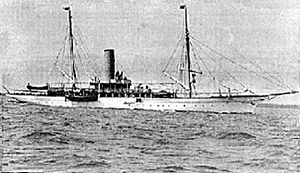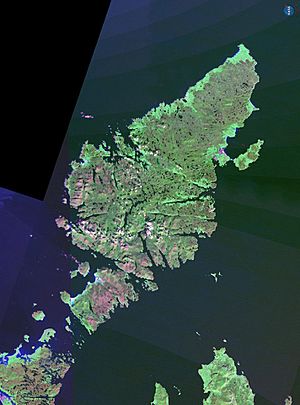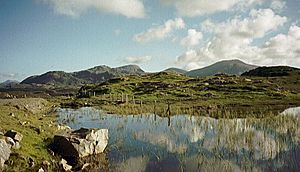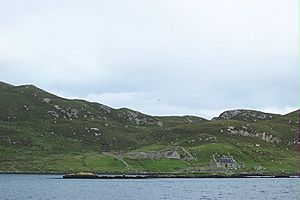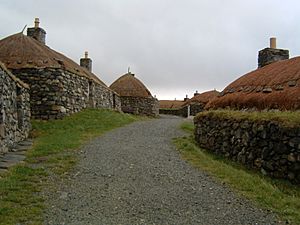Lewis facts for kids
Quick facts for kids Lewis |
|
|---|---|
 |
|
| Area | 683 sq mi (1,770 km2) |
| Population | 18,500 |
| • Density | 27/sq mi (10/km2) |
| Language | Scottish Gaelic English |
| OS grid reference | NB426340 |
| • Edinburgh | 276 miles (444 km) |
| Council area | |
| Lieutenancy area | |
| Country | Scotland |
| Sovereign state | United Kingdom |
| Post town | STORNOWAY ISLE OF LEWIS |
| Postcode district | HS1, HS2 |
| Dialling code | 01851 |
| Police | Northern |
| Fire | Highlands and Islands |
| Ambulance | Scottish |
| EU Parliament | Scotland |
| UK Parliament |
|
| Scottish Parliament |
|
Lewis (Scottish Gaelic: Leòdhas), also known as the Isle of Lewis, is the northern part of Lewis and Harris. This is the largest island in the Outer Hebrides, a group of islands off the coast of Scotland. Lewis covers an area of about 683 square miles (1,770 km2).
Lewis is generally flatter than the southern part of the island, Harris, which has more mountains. Because Lewis has flatter, more fertile land, most of the people in the Western Isles live here. The biggest town, Stornoway, is also on Lewis. The island has many different natural areas, which are home to various plants and animals. You can find golden eagles, red deer, and seals here. Many of these areas are protected to keep nature safe.
Lewis has a strong Presbyterian Christian tradition and a long history. It was once part of the Norse Kingdom of the Isles. Life on Lewis is still quite different from other parts of Scotland. For example, many people observe the Sabbath (Sunday) very strictly. The Gaelic language and the practice of cutting peat for fuel are also more important here than in other places. Lewis has a rich culture, with many interesting myths and legends, as well as local music and stories.
Contents
What's in a Name?
The Gaelic name for Lewis is Leòdhas. Some people think this name comes from the Norse word Ljoðahús, which means "song house." Others suggest it comes from the Gaelic word leogach, meaning "marshy" or "swampy." It might even be the place Ptolemy called Limnu, which also means "marshy."
Lewis is also known as the "Isle of Lewis" (in Gaelic: Eilean Leòdhais). Another name, often used in poems or songs, is Eilean an Fhraoich, which means "Heather Isle." This name refers to the whole island of Lewis and Harris, not just the northern part.
A Look Back: History of Lewis
The first signs of people living on Lewis come from peat samples. These show that about 8,000 years ago, much of the island's natural forests were burned. This created grasslands for deer to graze. The oldest archaeological finds are from about 5,000 years ago. At that time, people started living in permanent farms instead of moving around with their herds. Small houses from this period have been found across the Western Isles, especially at Dail Mhor, Carloway. The most impressive buildings from this time are the large stone circles and burial places, like the famous Calanais stones.
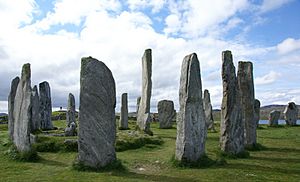
Around 500 BC, the island moved into the Iron Age. Buildings became bigger and more noticeable. The most impressive were the brochs. These were round towers made of dry stone, built by local chiefs. They show that life back then could be dangerous. The best example of a broch on Lewis is at Dùn Chàrlabhaigh. The Scots arrived in the first centuries AD, bringing the Gaelic language. As Christianity spread in the 6th century, Lewis was home to the Picts.
Vikings and the Kingdom of the Isles
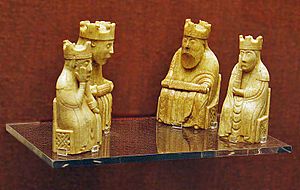
In the 9th century AD, the Vikings began to settle on Lewis after years of raiding from the sea. These Norse invaders married local people and stopped following their old pagan beliefs. During this time, rectangular buildings, like those in Scandinavia, became common instead of round ones. Lewis became part of the Kingdom of the Isles, which was connected to Norway. The famous Lewis chessmen, found on the island in 1831, are from the time of Viking rule. The people living here were called the Norse–Gaels, or Gall-Ghàidheil, which means "Foreigner Gaels." This name shows their mixed Scandinavian and Gaelic background. Many place names on the island still come from the Norse language today.
Lewis Joins Scotland
Lewis and the rest of the Western Isles became part of Scotland again in 1266. This happened under the Treaty of Perth, when Norway gave up control. Under Scottish rule, the Lord of the Isles became very powerful in northwest Scotland by the 14th century. These Lords controlled all the Hebrides islands.
Control of Lewis was first held by the Macleod clan. But after many years of fighting between clans, the Macleod lands were taken by the Scottish Crown in 1597. King James VI gave the land to a group of people from the Scottish Lowlands, called the Fife adventurers. He wanted to make the islands more English. However, these adventurers failed. In 1609, the land eventually went to the Mackenzies of Kintail, when Lord MacKenzie bought it.
Changes and Challenges
After the 1745 rebellion, the use of Gaelic was discouraged. People had to pay rent in money instead of goods, and wearing traditional folk clothes was made illegal. Many people who could afford it moved to the New World (America) in the late 1700s.
In 1844, Sir James Matheson bought Lewis. He was one of the founders of Jardine Matheson. But later, a famine and changes in how land was used forced many people off their farms. This led to even more people leaving the island. Sadly, those who stayed became very crowded and poor. Large areas of good farming land were used for sheep, deer hunting, or grouse shooting instead. People on Lewis started to demand land back in the 1880s, and there were several "land raids" where people took over land. This calmed down when the island's economy improved.
During the First World War, thousands of islanders joined the armed forces. Many lost their lives. This included 208 naval reservists who were returning home after the war when their ship, the HMY Iolaire, sank right near Stornoway harbour. Many Lewis servicemen also served in the Royal Navy and Merchant Navy during the Second World War, and more lives were lost. After the wars, many more people moved to the Americas and mainland Scotland.
In 1918, a rich soap maker named Lord Leverhulme bought the Isle of Lewis. He wanted to turn Stornoway into an industrial town and build a fish cannery. His plans were popular at first. But he was against giving land back to the people, which led to more land raids, especially around the farms of Coll, Gress, and Tong. These raids, remembered with monuments in several villages, were successful. The government even supported the people's right to the land. Because of this, Lord Leverhulme gave up his plans for Lewis and focused on Harris, where the town of Leverburgh is named after him.
Important Historical Places
Lewis has many interesting historical and archaeological sites:
- Callanish Stones: Ancient standing stones.
- Dun Carloway Broch: A well-preserved Iron Age tower.
- Iron Age houses near Bostadh (Great Bernera): Old homes from the Iron Age.
- The Garenin blackhouse village in Carloway and the Black House at Arnol: Traditional island homes.
- Bragar whale bone arch: An arch made from whale bones.
- St Columba's church in Aignish: An old church with historical ties.
- Teampull Mholuaidh in Ness: Another historic church.
- Clach an Truiseil monolith: A very tall standing stone.
- Clach Na Thursa, Carloway: Another historical stone.
- Bonnie Prince Charlie's Monument, Arnish: A monument linked to a famous historical figure.
- Lews Castle: A grand castle in Stornoway.
- Butt of Lewis cliffs and Butt of Lewis Lighthouse: Dramatic cliffs and a lighthouse at the northern tip.
- Dùn Èistean: A small island that was the ancient home of the Lewis Morrisons clan.
- Ui Church, burial place of the Clan Chiefs MacLeod of Lewis and MacKenzie: An important burial site.
There are also many smaller stone circles and the remains of five more brochs.
Lewis's Landscape and Rocks
If you were to look across Lewis, you would see sandy beaches with dunes and machair (fertile grassy plains) on the Atlantic west coast. Behind these, there's a huge area of peat-covered land in the island's center. The eastern coast is much rockier, with cliffs, small coves, and beaches. Because the eastern side has more fertile land, most people live there, including in the only town, Stornoway. Except for the village of Achmore in the middle, all settlements are on the coast.
Compared to Harris, Lewis is quite flat. However, there are some hills in the southwest, like Mealisval, which is 574 m (1,883 ft) high. In the southeast, Beinn Mhor reaches 572 m (1,877 ft). There are also 16 other high points over 300 m (980 ft). Southern Lewis also has many freshwater lochs (lakes) compared to the north.
The area called South Lewis, Harris and North Uist is a protected National Scenic Area. Lewis also has four special areas for geology, called Sites of Special Scientific Interest (SSSI).
The coastline of Lewis is very jagged, creating many large sea lochs. Lochs Resort and Seaforth form part of the border with Harris. Loch Roag surrounds the island of Great Bernera, and Loch Erisort is another large sea loch. The main points of land are the Butt of Lewis in the far north, with cliffs 142 ft (43 m) high and a lighthouse. Other capes include Tolsta Head, Tiumpan Head, and Cabag Head in the east, Renish Point in the south, and Toe Head and Gallon Head in the west. The largest island near Lewis is Great Bernera, which is connected to Lewis by a bridge built in 1953.
What is Lewis Made Of?
The rocks of Lewis are mostly made of metamorphic gneisses, which are part of the Lewisian complex. These are very old rocks that have been changed by heat and pressure. There are also some other types of rock, like granite near Carloway, and small areas of basalt and sandstone.
Lewis's Weather
Lewis has a cool, moist climate because it is close to the Atlantic Ocean and influenced by the Gulf Stream. There isn't a big difference in temperature between summer and winter. Both seasons are often cloudy, with a lot of rain and strong winds, especially in autumn. These strong winds have led to discussions about building a large wind farm on Lewis, which has caused some debate among local people.
| Climate data for Lewis | |||||||||||||
|---|---|---|---|---|---|---|---|---|---|---|---|---|---|
| Month | Jan | Feb | Mar | Apr | May | Jun | Jul | Aug | Sep | Oct | Nov | Dec | Year |
| Mean daily maximum °C (°F) | 7 (45) |
7 (45) |
8 (46) |
10 (50) |
12 (54) |
14 (57) |
16 (61) |
16 (61) |
14 (57) |
12 (54) |
9 (48) |
7 (45) |
11 (52) |
| Mean daily minimum °C (°F) | 2 (36) |
2 (36) |
2 (36) |
3 (37) |
6 (43) |
8 (46) |
10 (50) |
10 (50) |
8 (46) |
6 (43) |
4 (39) |
2 (36) |
5 (41) |
| Average rainfall mm (inches) | 134.41 (5.29) |
98.48 (3.88) |
93.86 (3.70) |
72.70 (2.86) |
61.86 (2.44) |
64.89 (2.55) |
74.21 (2.92) |
89.63 (3.53) |
106.44 (4.19) |
132.21 (5.21) |
132.37 (5.21) |
135.78 (5.35) |
1,197 (47.1) |
| Mean monthly sunshine hours | 34.46 | 63.43 | 104.85 | 147.07 | 192.18 | 166.44 | 127.94 | 132.57 | 106.63 | 77.19 | 44.26 | 26.21 | 1,223 |
| Source: Met Office (Data January 1874 – November 2006)
Temperature figures are average figures for that month; other figures are averages of monthly totals. |
|||||||||||||
Nature and Wildlife
Lewis has 15 Sites of Special Scientific Interest (SSSIs) that protect its wildlife. The Lewis Peatlands are also very important. They are recognized as a Special Protection Area, a Special Area of Conservation, and a Ramsar site. This shows how important these wetlands are for birds that live there or migrate through.
Birds of Lewis
Many types of seabirds live along the coast of Lewis. These include shags, gannets, fulmars, kittiwakes, guillemots, and many kinds of gulls. In the island's interior, you can find red grouse and woodcock.
In the hills of Uig, you might spot golden eagles. Some people have also reported seeing white-tailed eagles. In the Pairc area, you can see oyster catchers and curlews feeding. A few pairs of peregrine falcons live on the coastal cliffs. Merlins and buzzards are common everywhere on the hills and moors. In winter, many different kinds of wildfowl visit Lewis. Several types of duck, like eider and long-tailed ducks, can be found in the shallow waters around the island.
Marine Life
Salmon swim up several Lewis rivers after crossing the Atlantic Ocean. Many of the freshwater lochs are home to fish like trout. Other freshwater fish include Arctic char, European eel, sticklebacks, thick-lipped mullet, and flounder.
Out in the sea, it's common to see seals, especially in Stornoway harbour. If you're lucky, you might also see dolphins, porpoises, sharks, and even an occasional whale.
Land Mammals
Lewis has only two native land mammals: red deer and otters. Other animals like rabbits, blue hares, hedgehogs, brown and black rats, feral cats, mink, and polecats were brought to the island by people. It's not clear if mice and voles are native or were introduced.
American mink are another introduced species that escaped from fur farms. They cause problems for birds that nest on the ground, the local fishing industry, and chicken farmers. Mink have been successfully removed from the Uists and Barra. There's an ongoing project to remove mink from Lewis and Harris too.
Some people say that bats live in the Stornoway castle grounds. Also, some residents keep farm animals like Hebridean sheep, Highland cattle, and a few pigs.
Reptiles and Amphibians

Like Ireland, Lewis has no snakes. The only reptile is the slow-worm, which looks like a snake but is actually a legless lizard. The common frog can be found in the center of the island. However, frogs, newts, and toads were all introduced to Lewis.
Insects
The most famous insect on the island is the Scottish Highland midge. These tiny biting insects are always present near water at certain times of the year.
During the summer, you can find several types of butterflies and dragonflies, especially around Stornoway.
Lewis has a rich insect life, which is why you can find many carnivorous plants (plants that eat insects) growing in some parts of the island.
Plant Life
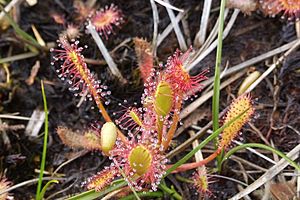
The machair areas are known for different kinds of orchids and other plants like various grasses. Three types of heather – ling, bell heather, and cross-leaved heather – are common in the large areas of moorland. These moorlands also have many insectivorous plants, such as sundews. The vast areas covered in heather explain why the island is sometimes called Eilean an Fhraoich, which is Gaelic for "The Heather Isle."
Lewis was once covered in forests. However, the only natural woods left are small patches on inland cliffs and on islands within lochs, where they are safe from fires and sheep. In recent years, the Forestry Commission has planted spruce and pine trees. Most of the pine trees were unfortunately destroyed by a moth problem. The most important mixed woods are those planted around Lews Castle in Stornoway, which date back to the mid-1800s.
People and Places
Lewis's main settlement is Stornoway (Steòrnabhagh). It's the only town in the Outer Hebrides. From Stornoway, ferries sail to Ullapool on the Scottish mainland. In 2001, Lewis had about 18,489 people living there.
Most of the island's villages are located on or near the coasts or sea lochs, especially on the northeast coast. The middle of the island is a large area of moorland. People traditionally cut peat here for fuel, though this is less common now. The southern part of the island, next to Harris, is more mountainous and has many inland lochs.
Areas and Villages of Lewis
Lewis is divided into different areas and villages.
- There are four main parishes: Barvas (Barabhas), Lochs (Na Lochan), Stornoway (Steòrnabhagh), and Uig.
- The traditional districts of Lewis are Ness (Nis), Carloway (Càrlabhagh), Back, Lochs (Na Lochan), Park (A' Phàirc), Point (An Rubha), Stornoway, and Uig.
- The West Side is a general name for the villages from Borve to Dalbeg.
It is said that the Stornoway War Memorial was placed where it is so that it could be seen from at least one spot in each of the four parishes. This means you might be able to see all four parishes of Lewis from the top of the monument!
Main Settlements
While Lewis only has one town, Stornoway, with about 8,000 people, there are also several large villages. These include North Tolsta, Carloway, and Leurbost. Villages near Stornoway like Laxdale, Sandwick, and Holm have become like suburbs of the town. If you include these, the population of the greater Stornoway area would be closer to 12,000.
The island of Great Bernera has Kirkibost, which was the first planned crofting township (a small farming community) created in the Outer Hebrides in 1805.
Here is a list of some villages in Lewis, grouped by their location:
- Back area
- Back, Coll, Gress, North Tolsta, Tong
- Ness area
- Melbost, South Galson, North Galson, South Dell, North Dell, Cross, Swainbost, Habost, Lionel, Port of Ness, Eoropie, Fivepenny, Knockaird, Adabrock, Eorodale, Skigersta, Cross-Skigersta Road
- North Lochs area
- Achmore, Grimshader, Leurbost, Ranish, Crossbost, Keose, Keose Glebe, Laxay, Balallan, Airidhbhruaich
- Park (South Lochs) area
- Shieldenish, Habost, Kershader, Garyvard, Caverstay, Cromore, Marvig, Calbost, Gravir, Lemreway, Orinsay
- Point area
- Aird, Aignish, Flesherin, Lower Bayble, Portnaguran, Portvoller, Sheshader, Shulishader, Upper Bayble, Eagleton
- Uig area
- Aird Uig, Cliff, Kneep, Timsgarry, Valtos, Breanish, Islivik, Meavik, Mangursta, Crowlista, Geishader, Carishader, Gisla, Carloway, Garynahine, Callanish, Breasclete, Breaclete, Kirkibost, Tobson, Hacklete
- West Side area
- Branahuie, Holm, Laxdale, Marybank, Melbost, Newmarket, Newvalley, Parkend, Plasterfield, Sandwick, Steinish
Religion in Lewis
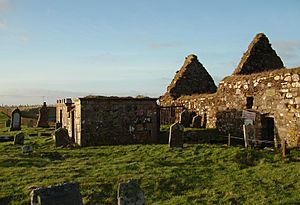
Religion is very important in Lewis. Most people belong to the Free Church and the Church of Scotland. Both of these are part of the Presbyterian tradition. The Sabbath (Sunday) is generally observed very strictly. Most shops and places that sell alcohol are closed on Sundays. However, there are scheduled flights to mainland Scotland and a ferry service that started in July 2009.
While Presbyterianism is the main religion, other Christian groups and religions are also present. In Stornoway, you can find a Catholic church, a Salvation Army building, a Pentecostal church, a Brethren church, a Baptist church, a meetinghouse for LDS Church, and a Jehovah's Witness Kingdom Hall.
Culture and Sports
Language and Heritage
Lewis has a rich language history, influenced by both Scottish Gaelic and Old Norse. Both Gaelic and English are spoken on Lewis today. In daily life, a mix of English and Gaelic is very common. Because of the Gaelic influence, the English accent on Lewis often sounds more like Irish or Welsh accents than typical Scottish ones. The Gaelic culture is stronger in the Western Isles than anywhere else in Scotland. Gaelic is the preferred language for many islanders. About 60% of people on the island speak Gaelic every day, and 70% have some knowledge of it. Most road signs on the islands are in both English and Gaelic.
Most place names in Lewis and Harris come from Old Norse. The name "Lewis" is the English way of spelling the Gaelic Leòdhas, which comes from the Old Norse Ljóðhús. This name was used on medieval Norwegian maps of the island.
Media and Arts
Lewis often hosts the Royal National Mòd, a big festival celebrating Gaelic culture. There are also local festivals each year. Stornoway Castle Green hosts the annual 3-day Hebridean Celtic Festival in July, which attracts over 10,000 visitors. This festival includes ceilidhs (traditional gatherings with music and dancing), dances, and special concerts with storytelling, songs, and music from performers across the islands and beyond.
The radio station Isles FM is based in Stornoway and broadcasts on 103FM. It plays a mix of Gaelic and English programs. Stornoway also has a studio for BBC Radio nan Gàidheal and Studio Alba, an independent TV studio that used to broadcast the Gaelic TV channel TeleG.
The Stornoway Gazette is the main local newspaper, covering Lewis and other areas. It comes out every week. The Hebridean is a sister paper that also provides local news. Some community groups in rural areas have their own publications, like the Rudhach for the Point district.
Lewis has been home to, or has inspired, many writers. This includes the popular author Kevin MacNeil, whose novel The Stornoway Way is set in the island's capital.
Sports and Activities
Lewis has good sports grounds and centers. Sports like Football, Rugby union, and Golf are popular.
- Football became very popular after the First World War. Goathill Park in Stornoway hosts special matches with local teams and visiting clubs. Local teams play in the Lewis and Harris Football League.
- Shinty, a traditional Scottish sport, used to be played on the island but died out by the mid-20th century. However, it was brought back in the 1990s. Now, there's a strong local club called Lewis Camanachd that competes in national competitions.
- The village of Tong, about 2 miles (3 km) from Stornoway, hosts the Highland Games and the Western Isles Strongest man competition every summer.
- The Ionad Spors Leòdhais (Lewis Sports Centre) is attached to the Nicolson Institute School. It has an all-weather pitch and a running track.
- The Lews Castle Grounds is home to the Stornoway Golf Club. It's the only 18-hole golf course in the Outer Hebrides.
- Angling (fishing) is a very popular hobby in Lewis. There are several good lochs and rivers for fishing.
- Since Lewis is an island, various water sports, like surfing, are popular activities.
- Lewis has great terrain for hillwalking, especially in Uig and near the border with Harris.
Myths and Legends
The Isle of Lewis has many old stories and legends. These include Seonaidh, a water-spirit who was offered ale near Teampull Mholuaidh in Ness. There are also stories of The Blue Men, who were said to live in the Minch, the stretch of water between Lewis and the Shiants.
Local Food
Every year, men from Ness travel to the island of Sula Sgeir in late August for two weeks. They go to harvest young gannets, which are known locally as Guga. This is a special local food.
Famous People with Lewis Connections
Many notable people have connections to Lewis:
- Alistair Darling: A former government minister and MP, whose family is from Bernera.
- Andy Gray: A former footballer and TV pundit, whose grandmother was from Back.
- Sheilagh M. Kesting: The first woman minister to be nominated as the leader of the Church of Scotland.
- Angus MacAskill: Known as the strongest man who ever lived, born in Berneray and lived briefly in Stornoway before moving to Canada.
- Murdo Stewart MacDonald: A Clipper Captain and shipping surveyor from Great Bernera.
- Callum Macdonald: A leading publisher of Scottish poetry in the 20th century, from Great Bernera.
- Cathy MacDonald: A main presenter on BBC Alba television, from Iarsiadar, Uig.
- John MacKay: An anchorman for STV News.
- Alexander MacKenzie: A famous explorer, after whom the Mackenzie River in Canada is named.
- Colin Mackenzie: The first Surveyor-General of India.
- Anne MacKenzie: A BBC current affairs and radio presenter.
- Ken MacLeod: A science fiction writer.
- Kevin MacNeil: A novelist, poet, and playwright.
- Hans Matheson: An actor who played the main role in a TV series of Doctor Zhivago.
- Linda Norgrove: An aid worker who was kidnapped in Afghanistan.
- Alyth McCormack: A singer.
- Iain Morrison: A musician.
- Jim Morrison: The Morrison family originally came from the Isle of Lewis.
- Arthur Pink: A Christian evangelist and Bible scholar.
- Donald Stewart: A politician and former leader of the Scottish National Party.
- Derick Thomson: A Scottish Gaelic poet, from Point, who was educated in Stornoway.
- Donald Trump: The former president of the United States, whose mother Mary Anne MacLeod Trump came from Tong.
- Alasdair White: A musician who plays fiddle, whistle, pipes, and bouzouki with the band Battlefield Band.
See also
 In Spanish: Lewis para niños
In Spanish: Lewis para niños


